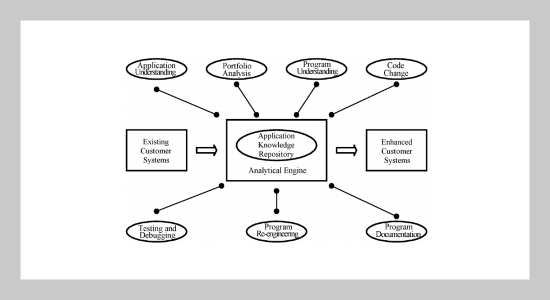REFERENCES
- [1] Szyperski, C., Component Software – Beyond ObjectOriented Programming, Reading, Masachusetts, Addison-Wesley (1998).
- [2] Taylor, D., Business Engineering with Object Technology, Wiley, New York, U.S.A. (1995).
- [3] Canfora, G., Cimitile, A., Lucia, A. De and Lucca, G. Di, “Decomposing Legacy Programs: A First Step towards Migrating to Client-Server Platforms,” Proceedings of the 6th International Workshop on Program Comprehension, IEEE Computer Society Press, pp. 136�144 (1998).
- [4] Cimitile, A., DeCarlini, U. and Lucia, A. De, “Incremental Migration Strategies: Data Flow Analysis for Wrapping,” Proceedings of the 5th Working Conference on Reverse Engineering, IEEE Computer Society Press, pp. 59�68 (1998).
- [5] Lucia, A. De, Lucca, G. Di, Fasolino, A., Guerra, P. and Petruzzelli, S., “Migrating Legacy Systems towards Object-Oriented Platforms,” Proceedings of International Conference on Software Maintenance, IEEE Computer Society Press, pp. 122�129 (1997).
- [6] Dietrich, W., “Saving a Legacy with Objects,” Proceedings on Object-Oriented Programming Systems, Languages and Applications, pp. 77�83 (1989).
- [7] Mowbray, T. and Zahavi, R., The Essential CORBA: Systems Integration Using Distributed Objects, Wiley, New York, U.S.A. (1995).
- [8] BEA, The Advantage of Unified Application and Integration Infrastructure, BEA White Paper, BEA Systems (2003).
- [9] Reed, B., Market Demands Drive XML Middleware, Technical Report, Technical Enterprise Inc. (2003).
- [10] Sneed, H., “Encapsulating Legacy Systems for Use in Client/Server Systems,” Proceedings of the 3rd Working Conference on Reverse Engineering, IEEE Computer Society Press, pp. 104�119 (1996).
- [11] Sneed, H., “Encapsulation of Legacy Software: a Technique for Reusing Legacy Software Components,” Annals of Software Engineering, Vol. 9, pp. 293�313 (2000).
- [12] Sneed, H., “Using XML to Integrate Existing Software Systems into the Web,” Proceedings of 26th International Computer Software and Applications Conference, IEEE Computer Society Press, pp. 167�172 (2002).
- [13] Emmerich, W., “Software Engineering and Middleware: a Roadmap,” Proceedings of the conference on the Future of Software Engineering, pp. 117�129 (2000).
- [14] Juric, M., Rozman, I. and Hericko, M., “Performance Comparison of CORBA and RMI,” Information and Software Technology, Vol. 42, pp. 915�933 (2000).
- [15] Pritchard, J., COM and CORBA – Side by Side, Reading, Masachusetts, Addison-Wesley (1999).
- [16] Jacobsen, H.-A. and Kramer, B., “A Design Pattern Based Approach to Generating Synchronization Adaptors from Annotated IDL,” Proceedings of the Automated Software Engineering Conference, IEEE Computer Society Press, pp. 63�72 (1998).
- [17] Gannod, G., Mudiam, S. and Lindquist, T., “An Architecture-Based Approach for Synthesizing and Integrating Adapters for Legacy Software,” Proceedings of the 7th Working Conference on Reverse Engineering, IEEE Computer Society Press, pp. 128�137 (2000).
- [18] Gamma, E., Helm, R., Johnson, R. and Vlissides, J., Design Patterns: Elements of Reusable Object-Oriented Software, Reading, Massachusetts, Addison-Wesley (1995).
- [19] Arulanthu, A., O’Ryan, C., Schmidt, D. and Kircher, M., “The Design and Performance of a Scalable ORB Architecture for CORBA Asynchronous Messaging,” Proceedings of the IFIP/ACM International Conference on Distributed Systems Platforms, pp. 208�230 (2000).
- [20] Brunsch, D., O’Ryan, C. and Schmidt, D., “Designing an Efficient and Scalable Server-Side Asynchrony Model for CORBA,” ACM SIGPLAN Notices, Vol. 36, pp. 223�229 (2001).
- [21] Chiang, C.-C., “Leveraging Software Reengineering Systems for Heterogeneous Distributed Computing Environments,” Proceedings of the International Conference on Software Maintenance 2000 in Silicon Valley, IEEE Computer Society Press, pp. 254�261 (2000).
- [22] Bass, L., Clements, P. and Kazman, R., Software Architecture in Practice, Reading, Massachusetts, Addison-Wesley (1998).
- [23] Chiang, C.-C., “Wrapping Legacy Systems for Use in Heterogeneous Computing Environments,” Information and Software Technology, Vol. 4, pp. 497�507 (2001).
- [24] Coplien, J., Advanced C++: Programming Styles and Idioms, Reading, Massachusetts, Addison-Wesley (1992).
















